Microarrayer:
Samples should be present in 96 or 384-well plates. Solution should be filtered (0.2 µm). For FTIR imaging analysis of proteins, samples concentration should be at least 5 mg/ml. Samples will be mixed in the multi-well plate with ethylene glycol 1:1 (v:v) to obtain the viscosity necessary for printing the microarrays. It is evaporated before FTIR imaging.
FTIR imaging:
Samples are prepared as 100 pl spots by the microarrayer. Avoid buffers containing molecules that absorb in the same spectral area as proteins. Typically, carboxylic acids (acetate, EDTA) should be avoided. Keep the amount of buffer and salts as low as acceptable. Example of adequate buffer: Tris, Hepes, phosphate. For hydrogen-deuterium exchange experiments, pH must be precisely measured.
Standard ATR-FTIR:
Same requirement as for FTIR imaging. Protein concentration is preferably at least 1 mg/ml. One measurement uses about 1-5 µl. Aggregates are acceptable. Critical point for ATR-FTIR: the weight of the dried buffer (including salts and detergent) materials should not exceed the weight of protein to be studied. This must be computed before attempting any experiment. The protein/lipid ratio (w/w) should be at least 10 %. For dichroism experiments (measure of molecular orientations) in membrane proteins, if possible select a lipid that forms well-oriented lipid multilayers. For hydrogen-deuterium exchange experiments, pH must be precisely measured.
